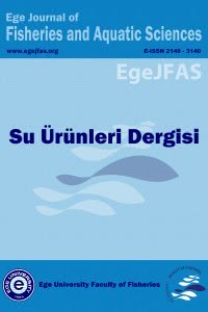Güney tıbbi sülüğü, Hirudo verbana Carena, 1820 yetiştiriciliğinde farklı ortamların koza ve yavru sayısına etkisi
Effects of various environments on number of cocoon and offspring in breeding of southern medicinal leech, Hirudo verbana Carena, 1820
___
- Abobatta, W. (2018). Impact of hydrogel polymer in agricultural sector. Advances in Agriculture and Environmental Science: Open Access (AAEOA), 1(2), 59–64. DOI: 10.30881/aaeoa.00011
- Ahmed, E.M. (2015). Hydrogel: Preparation, characterization, and applications: A review. Journal of Advanced Research, 6(2), 105–121. DOI: 10.1016/j.jare.2013.07.006
- Ceylan, M., Çetinkaya, O., Küçükkara, R., & Akçimen, U. (2015). Reproduction efficiency of the medicinal leech Hirudo verbana Carena, 1820. Turkish Journal of Fisheries and Aquatic Sciences, 15, 411–418. DOI: 10.4194/1303-2712-v15_2_27
- CITES. (2019). CITES national export quotas for 2019. Retrieved January 13, 2020, from https://cites.org/eng/export_quotas/CITES_National_ExportQuotas.doc
- Elliott, J.M. (2008). Population size, weight distribution and food in a persistent population of the rare medicinal leech, Hirudo medicinalis. Freshwater Biology, 53(8), 1502-1512. DOI: 10.1111/j.1365-2427.2008.01978.x
- Elliott, J.M. & Kutschera, U. (2011). Medicinal Leeches: Historical use, Ecology, Genetics and Conservation. Freshwater Reviews, 4(1), 21–41. DOI: 10.1608/FRJ-4.1.417
- Gileva, O. & Mumcuoglu, K. (2013). Hirudotherapy. In Biotherapy - History, Principles and Practice (pp. 31–76). DOI: 10.1007/978-94-007-6585-6_3
- J. Wilkin, P. & M. Scofield, A. (1991). Growth of the medicinal leech, Hirudo medicinalis, under natural and laboratory conditions. Freshwater Biology, 25, 547–553. DOI: 10.1111/j.1365-2427.1991.tb01398.x
- Küster, E. (1972). Microbiology of Peat. In Acta Horticulturae (pp. 23–28). International Society for Horticultural Science (ISHS), Leuven, Belgium. DOI: 10.17660/ActaHortic.1972.26.3
- Kutschera, U. & Elliott, J. (2014). The European medicinal leech Hirudo medicinalis L.: Morphology and occurrence of an endangered species. Zoosystematics and Evolution, 90(2), 271–280. DOI: 10.3897/zse.90.8715
- Kutschera, U. & Roth, M. (2006). Cocoon deposition and cluster formation in populations of the leech Hirudo verbana (Hirudinea: Hirudinidae). Lauterbornia, 56, 5–8.
- Kutschera, U. & S Shain, D. (2019). Hirudinea Lamarck 1818: Evolutionary origin and taxonomy of the six medicinal leeches (genus Hirudo) known today. Biomedical Research and Reviews, 3(1), 1–4. DOI: 10.15761/brr.1000126
- Malek, M., Jafarifar, F., Roohi Aminjan, A., Salehi, H. & Parsa, H. (2019). Culture of a new medicinal leech: growth, survival and reproduction of Hirudo orientalis Utevsky and Trontelj, 2005 under laboratory conditions. Journal of Natural History, 53(11-12), 627-637. DOI: 10.1080/00222933.2019.1597200
- Manav, M., Ceylan, M. & Büyükçapar, H.M. (2019). Investigation of reproductive efficiency, growth performance and survival of the southern medicinal leech, Hirudo verbana Carena, 1820 fed with mammalian and poultry blood. Animal Reproduction Science, 206, 27-37. DOI: 10.1016/j.anireprosci.2019.05.004
- McLoughlin, N.J. & Davies, R.W. (1996). The effects of feeding regime on the growth and reproduction of the medicinal leech Hirudo medicinalis. Freshwater Biology, 36(3), 563–568. DOI: 10.1046/j.1365-2427.1996.00121.x
- Narjary, B., Aggarwal, P., Kumar, S. & Meena, M. D. (2013). Significance of hydrogel. Indian Farming, 62(10), 15–17. Official Gazette (2014). Regulation on Traditional and Complementary Medicine Practices. Official gazette, (29158), 27.
- Petrauskiene, L., Utevska, O. & Utevsky, S. (2009). Can different species of medicinal leeches (Hirudo spp.) interbreed? Invertebrate Biology, 128(4), 324–331. DOI: 10.1111/j.1744-7410.2009.00180.x
- Saglam, N. (2017). Basic Principles of Breeding of Medicinal Leech, Hirudo verbana. In International Scientific Conference (Caucasus ecosystem: Past, Present and Future (80 years of the zoological investigations of the Caucasus) (pp. 501–506)
- Saglam, N. (2018). The effects of environmental factors on leeches. Advances in Agriculture and Environmental Science: Open Access, 1, 1–3. DOI: 10.30881/aaeoa.00001
- Saidel, W.M., Saglam, N., Salas-de la Cruz, D., Saunders, R. & Shain, D. H. (2018). Elaborate ultrastructure of the Hirudo (Annelida: Hirudinae) cocoon surface. Journal of Morphology, 279(4), 545–553. DOI: 10.1002/jmor.20787
- Spencer, W. & Jones, G. (2007). The captive breeding and educational display of the Medicinal leech Hirudo medicinalis (Linnaeus 1758) at Bristol Zoo Gardens. International Zoo Yearbook, 41(1), 138–144. DOI: 10.1111/j.1748-1090.2007.00005.x
- Wilkin, P.J. (1989). The medicinal leech, Hirudo medicinalis (L.) (Hirudinea: Gnathobdellae), at Dungeness, Kent. Botanical Journal of the Linnean Society, 101(1), 45-57. DOI: 10.1111/j.1095-8339.1989.tb00135.x
- Zhang, B., Lin, Q., Lin, J., Chu, X. & Lu, J. (2008). Effects of broodstock density and diet on reproduction and juvenile culture of the Leech, Hirudinaria manillensis Lesson, 1842. Aquaculture, 276(1), 198–204. DOI: 10.1016/j.aquaculture.2008.02.003
- ISSN: 1300-1590
- Yayın Aralığı: 4
- Başlangıç: 1984
- Yayıncı: Aynur Lök
Elifcan DUMAN, Can ALTINELATAMAN
Caudal osteology and its application to reconstruct phylogenetic relationship in the genus Garra
SEVİL SUNGUR, Soheil EAGDERİ, Pariya JALİLİ, ERDOĞAN ÇİÇEK
Theophilus Miebi GBIGBI, Felix O. ACHOJA
Türkiye’de üçüncü kuşak balıkçı gemisi geri-alım programının analizi
Vahdet ÜNAL, Huriye Göncüoğlu BODUR
Paraketa balıkçılığında kullanılan farklı yemlerin avcılık performansı ve olta iğnesinde kalma oranı
Ramazan Serezli, Bahadır Uğural
Yaşar DURMAZ, Gökhun Çağatay ERBİL
Microplastic pollution in freshwater ecosystems: A case study from Turkey
Ordu ve Samsun’da su ürünleri tüketim tercihleri ve alışkanlıklarının karşılaştırılması
